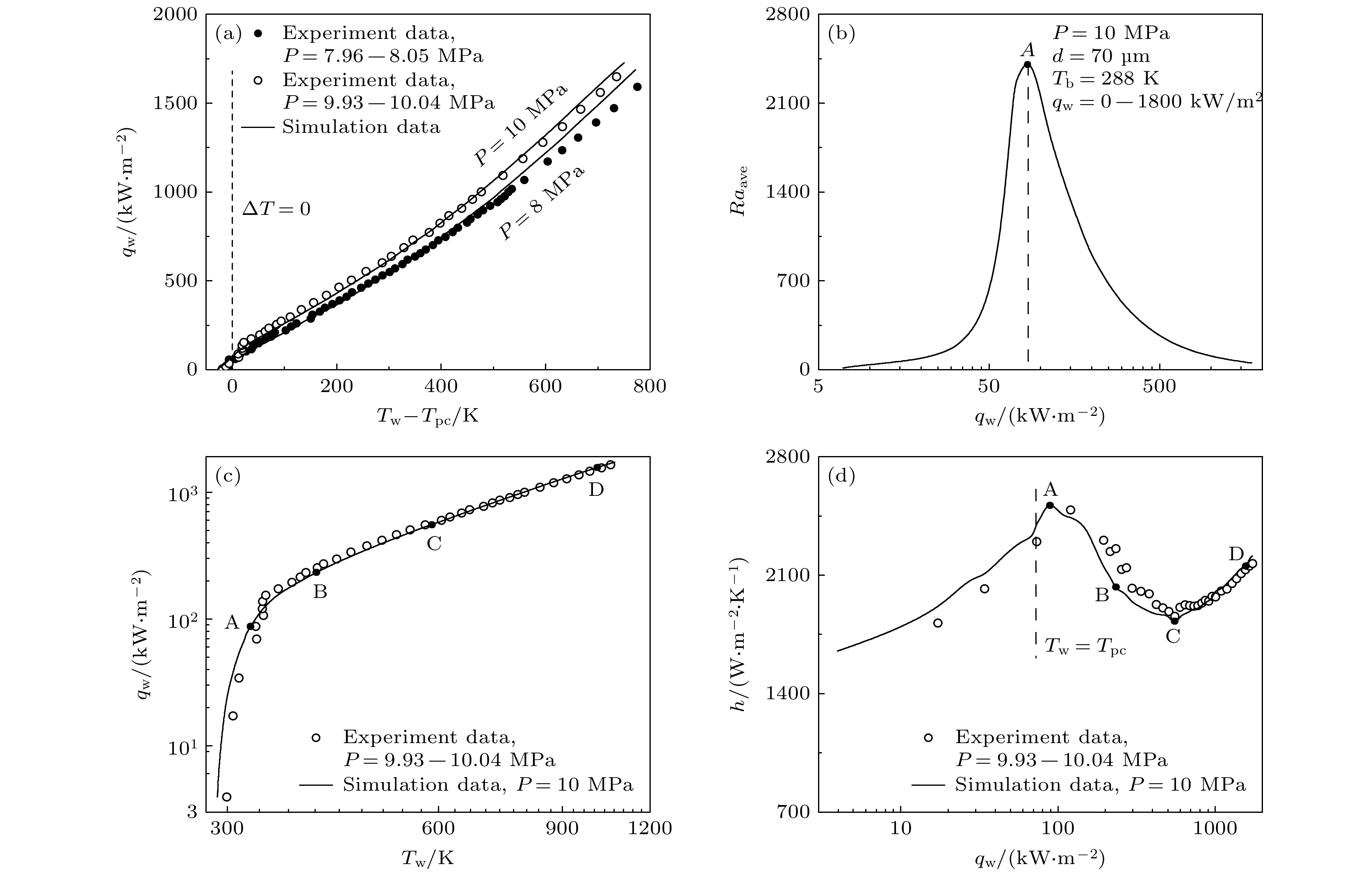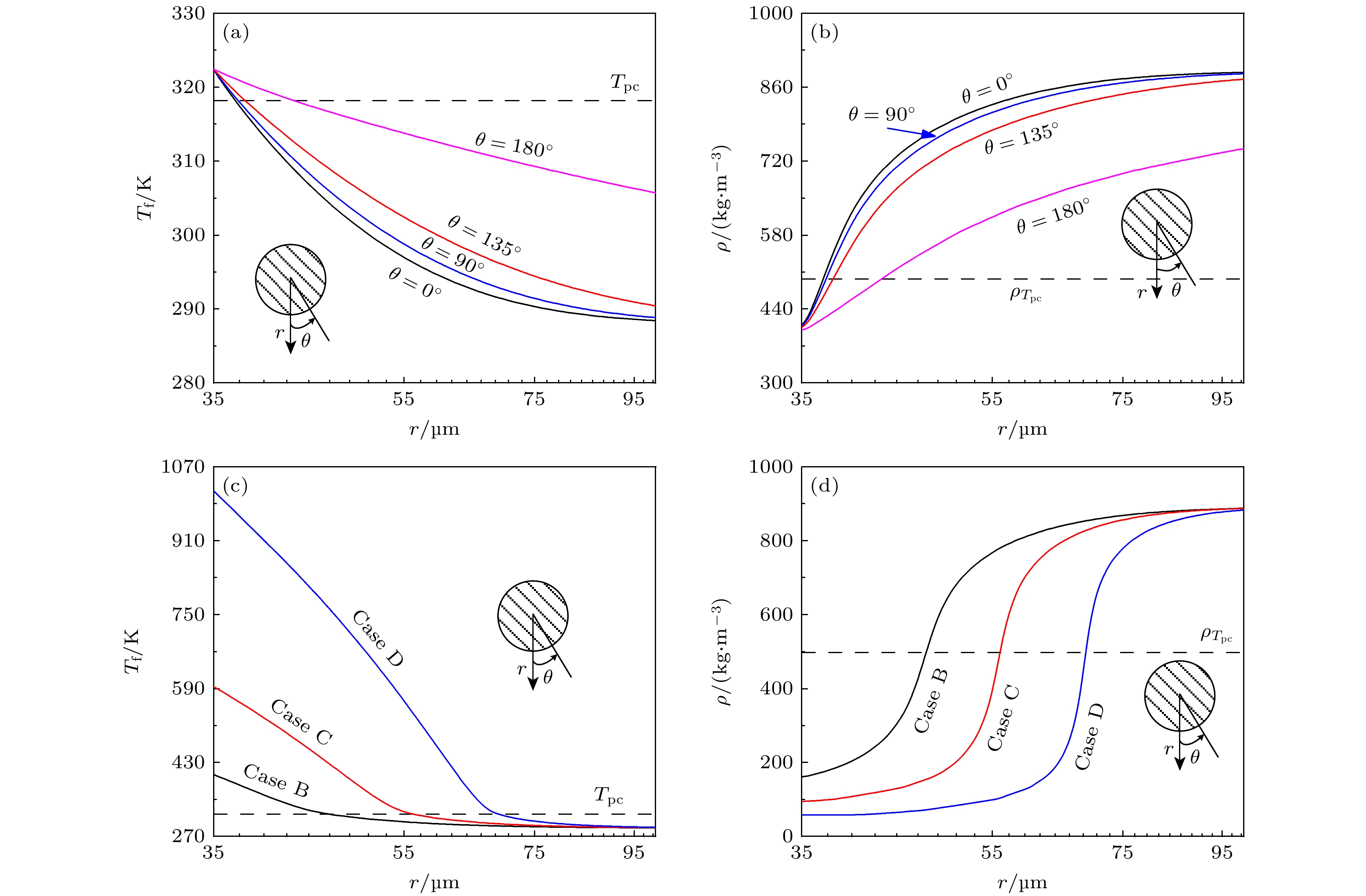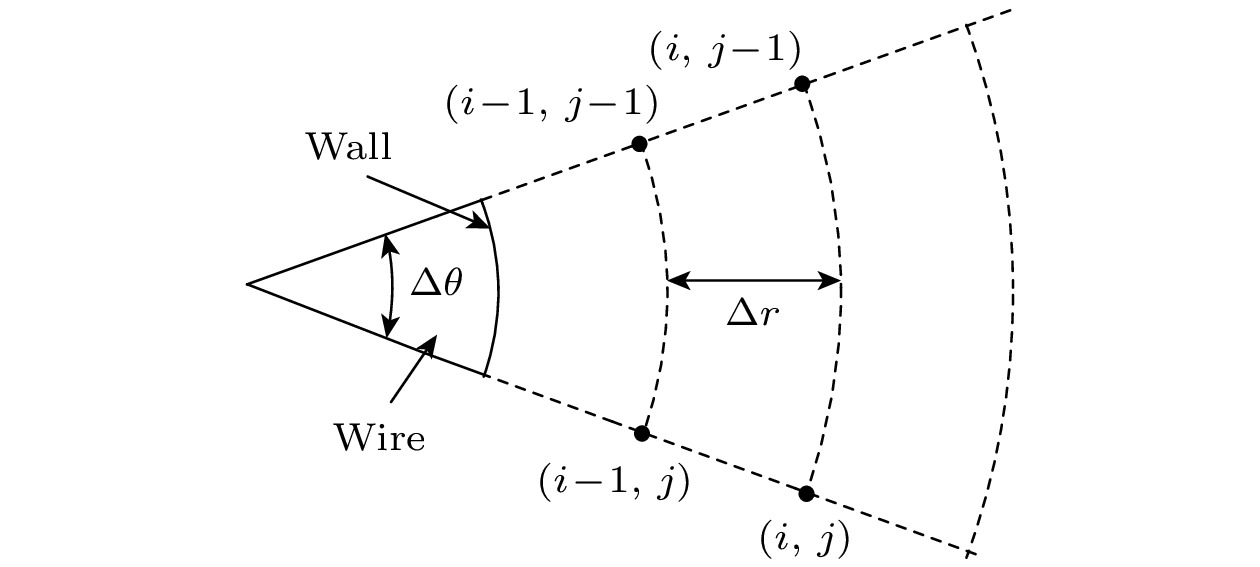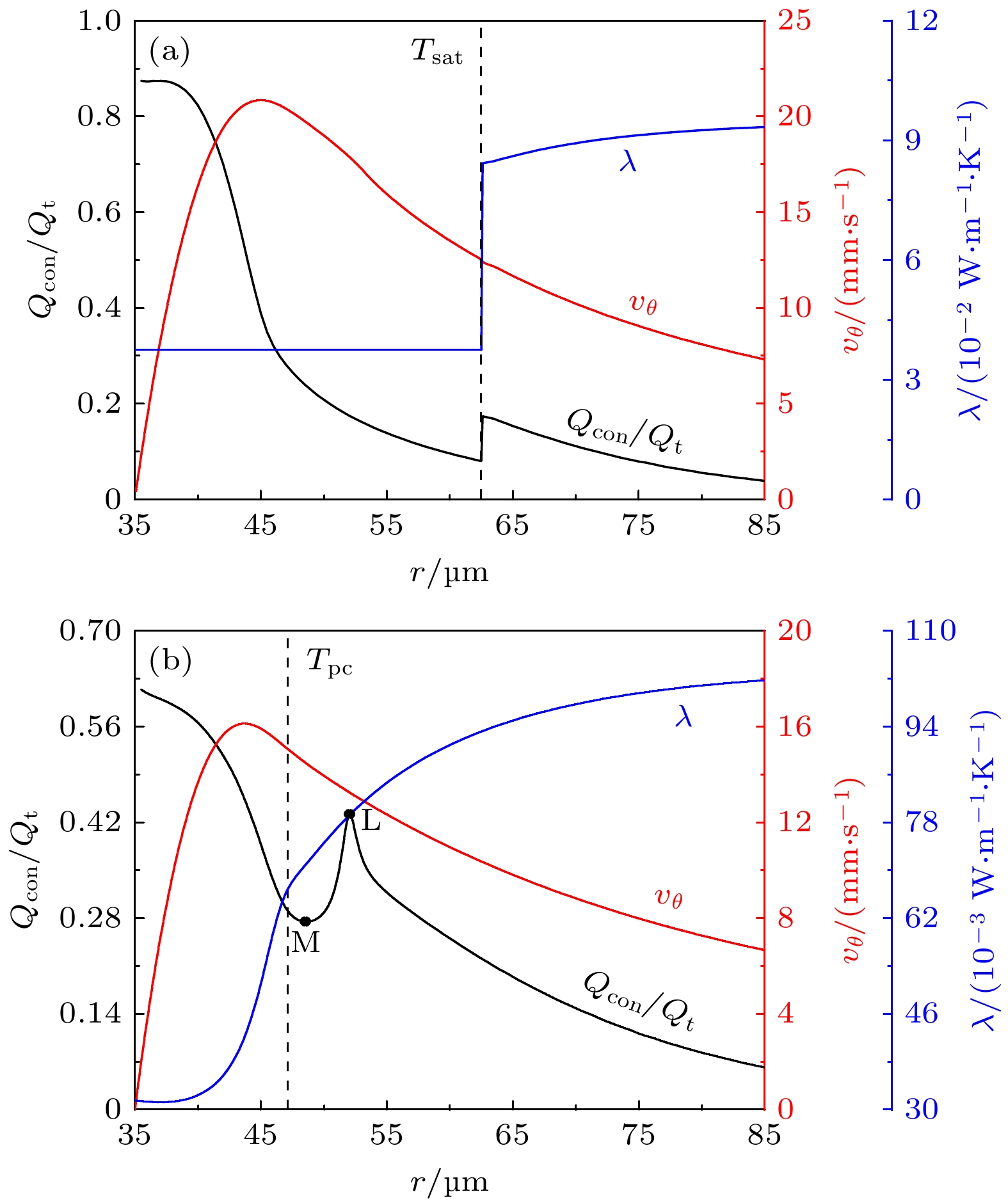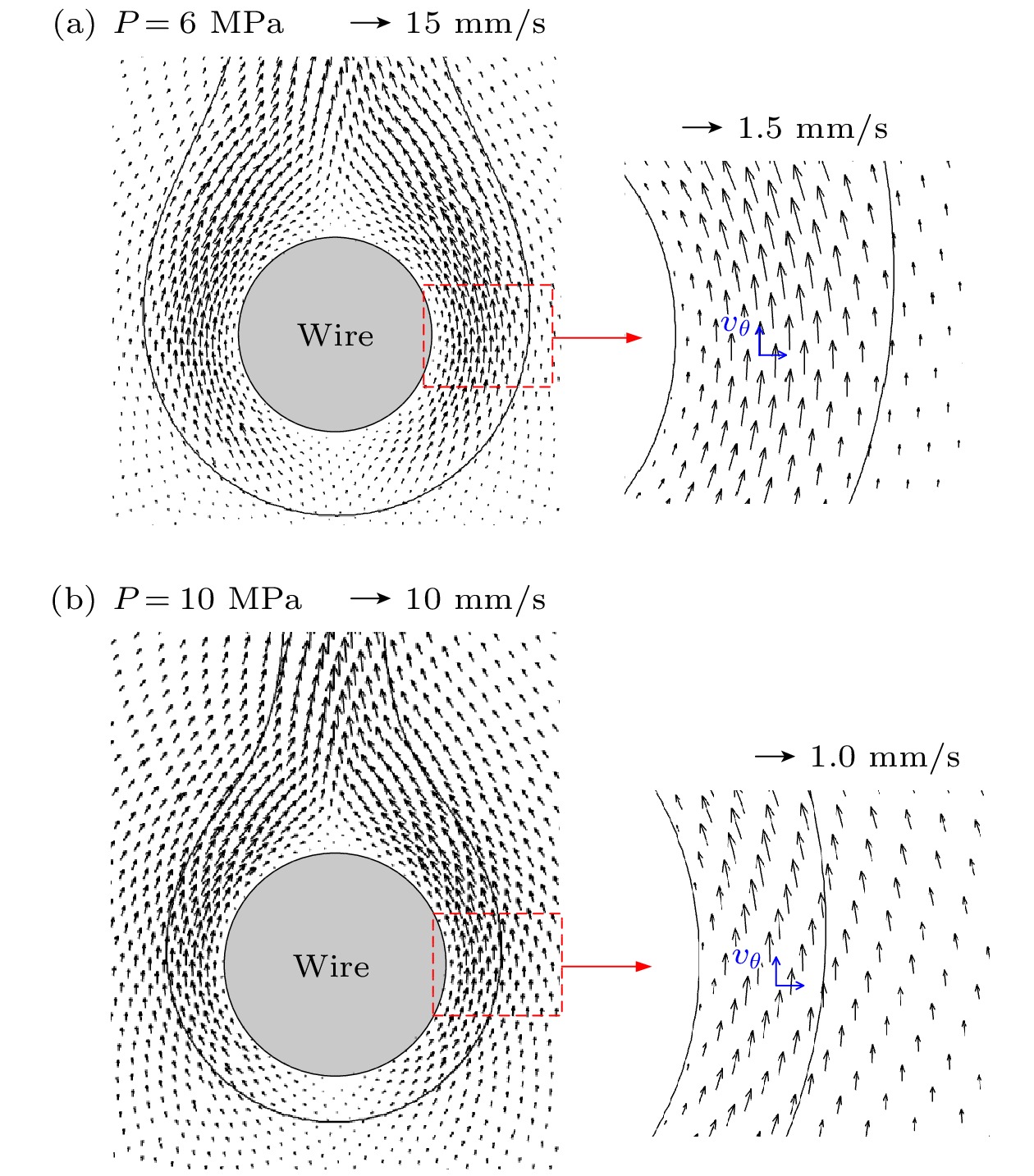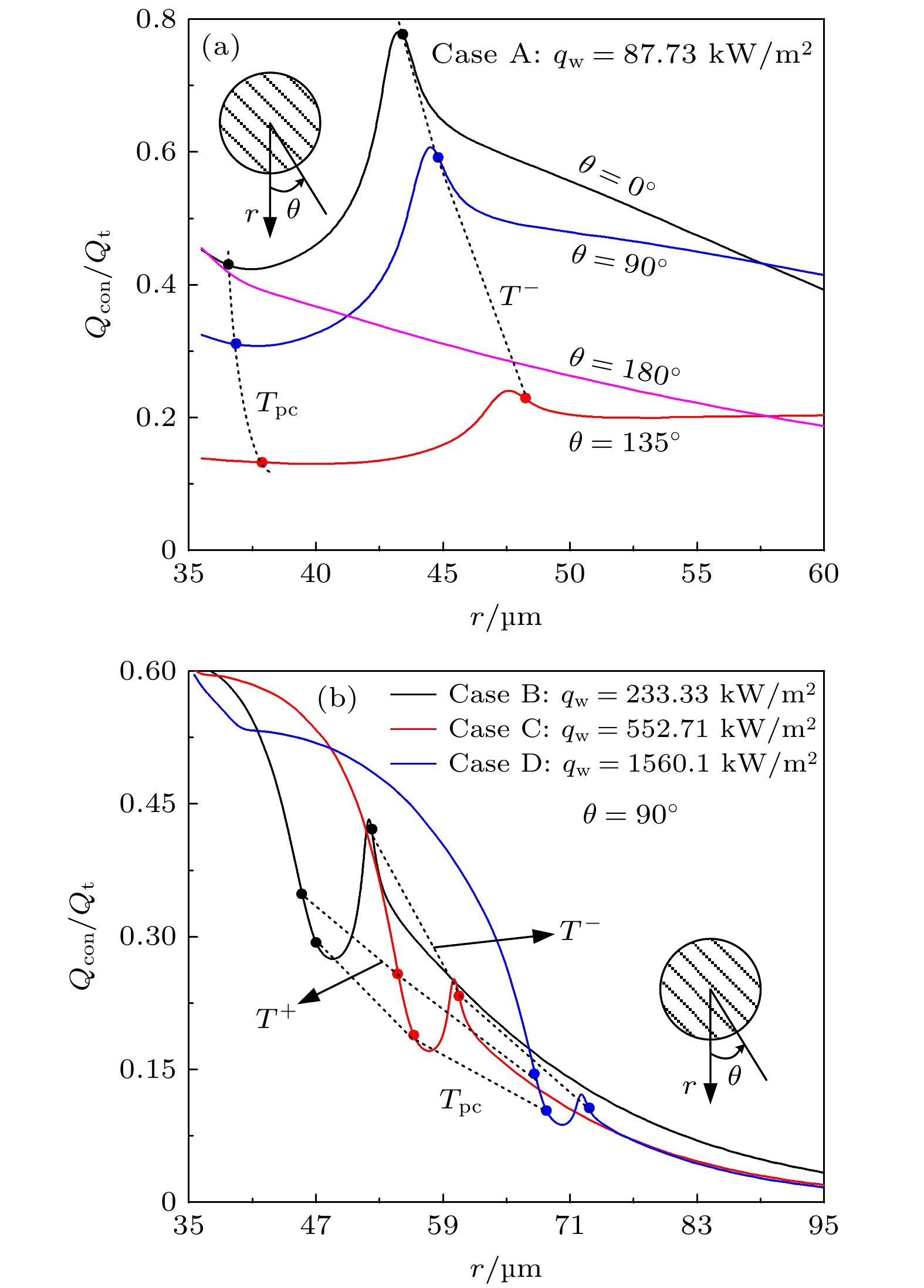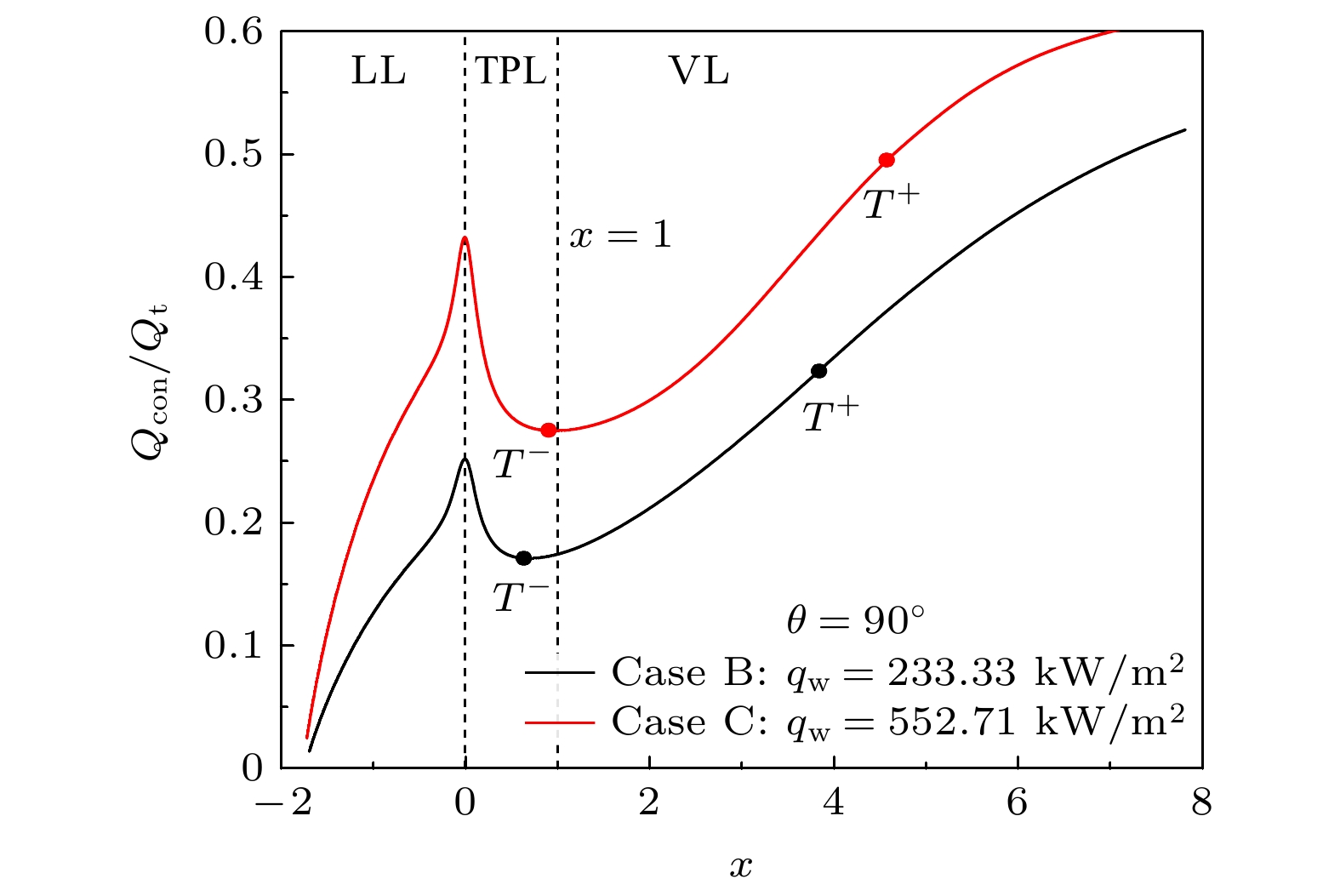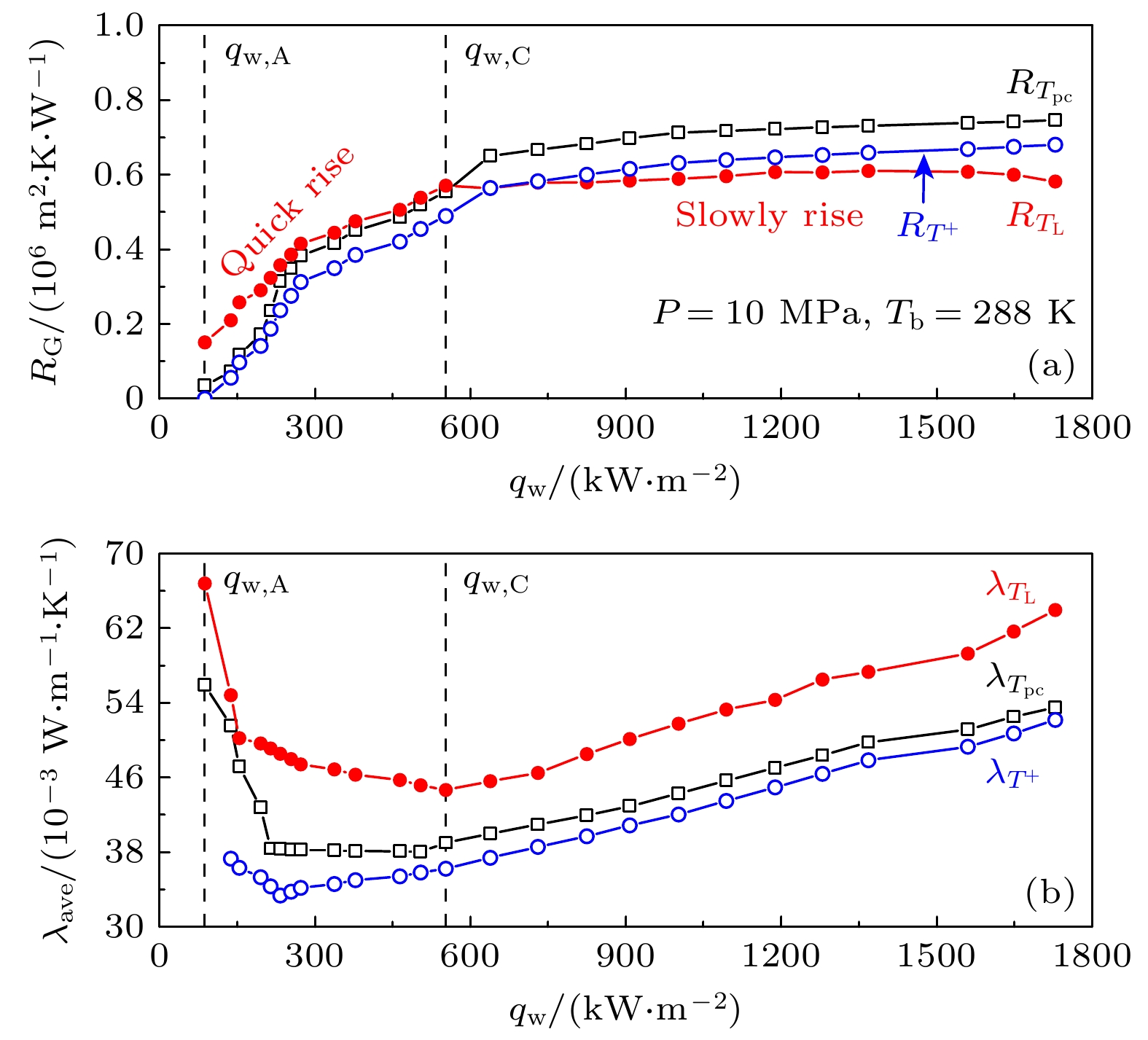-
超临界类沸腾传热已有初步研究, 对类气-类液界面的定义仍不统一. 采用层流模型对超临界CO2池式传热特性进行流固耦合数值模拟研究, d = 70 μm的铂丝为加热件, 热流密度qw范围为0—2000 kW/m2, 压力P范围为8—10 MPa, 加热丝附近采用多尺度网格进行建模, 模拟值与实验数据吻合较好. 通过与亚临界传热类比通过计算导热占比Qcon/Qt沿r方向变化规律, 将超临界划分为3个区, 当T < TL时为类液区 (liquid-like, LL), TL < T < TM时为类液向类气转变的过度区 (two-phase-like, TPL), T > TM为类气区 (vapor-like, VL), 与用超临界类沸腾干度x分区规律相同; 根据通过计算导热占比确定的类气膜内平均导热λave和导热热阻RG随热流密度qw变化曲线可很好地解释类蒸发区换热系数h随qw的变化规律. 本文提出了确定超临界池式传热类气-类液界面的新方法, 较好地解释了类蒸发区传热机理, 为后续超临界类沸腾池式传热的发展提供了理论基础.The heat transfer of supercritical pseudo-boiling has been preliminarily studied, but the definition of gas-liquid interface is still not unified. The fluid-structure coupling numerical simulation of heat transfer characteristics in supercritical CO2 pool is carried out by using laminar flow model. Platinum wire is the heating element, with diameter d = 70 μm. The heat flux density qw is in a range of 0–2000 kW/m2, and the pressure P is in a range of 8–10 MPa. Multi-scale mesh is used to model the heating wire, and simulation values accord well with the experimental data. The results show that due to the increase of the circumferential average Rayleigh number Raave of the heating filament with qw, the characteristic of the natural convection zone is that h increases with qw. The temperatures of the four characteristic working conditions in the evaporation-like zone show a downward trend along the r direction. Through analogy with subcritical heat transfer and by calculating the thermal conductivity ratio Qcon/Qt, the supercritical is divided into three regions, T < TL is liquid-like region (LL), TL < T < TM is two-phase-like region (TPL), T > TM is vapor-like region (VL). The rule is the same as that of x partition according to supercritical pseudo-boiling dryness. According to the curves of average thermal conductivity λave and thermal resistance RG versus heat flux qw, determined by calculating thermal conductivity ratio, the variation law of heat transfer coefficient h with qw in evaporation-like region can be well explained, as qw increases, the thermal conductivity thermal resistance RG increases, and the heat from the heating filament is difficult to transfer to the fluid outside the vapor-like membrane, leading the heat transfer coefficient h to decrease when qA < qw < qC, and a significant increase in λave when qw > qC, and the recovery of heat transfer when h rises again. In this paper, a new method of determining the gas-liquid interface of supercritical pool heat transfer is proposed. This method can effectively explain the heat transfer mechanism in the evaporation-like zone, and provide a theoretical basis for developing supercritical pool heat transfer in the future.
-
Keywords:
- supercritical /
- pool heat transfer /
- fluid-structure coupling /
- numerical simulation
[1] Tsai W C, Wang Y D 2019 Prog. Polym. Sci. 98 101161
 Google Scholar
Google Scholar
[2] Knez Z, Markocic E, Leitgeb M, Primozic M, Hrncic M K, Skerget M 2014 Energy 77 235
 Google Scholar
Google Scholar
[3] Sarkar J 2015 Renew Sust. Energ Rev. 48 434
 Google Scholar
Google Scholar
[4] Liu Y P, Wang Y, Huang D G 2019 Energy 189 115900
 Google Scholar
Google Scholar
[5] Kafengauz N L, Fedorov M I 1966 J. Eng. Phys. 11 99
 Google Scholar
Google Scholar
[6] Ackerman J W 1970 J. Heat Trans. 92 490
 Google Scholar
Google Scholar
[7] Knapp K K, Sabersky R H 1965 Int. J. Heat Mass Transfer 9 41
 Google Scholar
Google Scholar
[8] Abadzic E, Goldstein R J 1970 Int. J. Heat Mass Transfer 13 1163
 Google Scholar
Google Scholar
[9] Tamba J, Takahashi T, Ohara T, Aihara T 1998 Exp. Therm. Fluid Sci. 17 248
 Google Scholar
Google Scholar
[10] Zhu B G, Xu J L, Yan C S, Xie J 2020 Int. J. Heat Mass Transfer 148 119080
 Google Scholar
Google Scholar
[11] Xu J L, Zhang H S, Zhu B G, Xie J 2020 Sol. Energy 195 27
 Google Scholar
Google Scholar
[12] Zhua B G, Xu J L, Wua X M, Xie J, Li M J 2019 Int. J. Therm. Sci. 136 254
 Google Scholar
Google Scholar
[13] Huang D, Wu Z, Sunden B, Li W 2016 Appl. Energ. 162 494
 Google Scholar
Google Scholar
[14] Rousselet Y, Warrier G 2012 J. Heat Transfer 135 022501
 Google Scholar
Google Scholar
[15] Warrier G, Rousselet Y 2012 J. Heat Transfer 135 022502
 Google Scholar
Google Scholar
[16] 张海松, 徐进良, 朱鑫杰 2021 物理学报 70 044401
 Google Scholar
Google Scholar
Zhang H S, Xu J L, Zhu X J 2021 Acta Phys. Sin. 70 044401
 Google Scholar
Google Scholar
[17] Cheng L Y, Wang Q Y, Xu J L, 2024 Int. J. Heat Mass Transfer 220 124953
 Google Scholar
Google Scholar
[18] He X T, Xu J L, Yu X J, Xie J 2023 Int. J. Heat Mass Transfer 214 124417
 Google Scholar
Google Scholar
[19] 何孝天, 徐进良, 程怡玮 2023 物理学报 72 057801
 Google Scholar
Google Scholar
He X T, Xu J L, Cheng Y W 2023 Acta Phys. Sin. 72 057801
 Google Scholar
Google Scholar
[20] Simeoni G G, Bryk T, Gorelli F A, Krisch M, Ruocco G, Santoro M, Scopigno T 2010 Nat. Phys. 6 503
 Google Scholar
Google Scholar
[21] Maxi F, Contescu C, Boillat P, Niceno B, Karalis K, Testino A, Ludwig C H 2019 Nat. Commun. 19 12117
 Google Scholar
Google Scholar
[22] Banuti D T 2015 J. Supercrit. Fluid 98 12
 Google Scholar
Google Scholar
[23] Xu J L, Wang Y, Ma X J 2021 Phys. Rev. 104 014142
 Google Scholar
Google Scholar
[24] Wang Q Y, Ma X J, Xu J L, Li M J, Wang Y 2021 Int. J. Heat Mass Transfer 181 121875
 Google Scholar
Google Scholar
[25] 闫晨帅, 徐进良 2020 物理学报 4 044401
 Google Scholar
Google Scholar
Yan C S, Xu J L 2020 Acta Phys. Sin. 4 044401
 Google Scholar
Google Scholar
[26] Tripathi P M, Basu S 2021 Phys. Fluids 33 043304
 Google Scholar
Google Scholar
[27] Li X L, Yu X Y, Liu P T, Fan Y H, Yang D L, Tang G H 2023 Int. J. Heat Mass Transfer 216 124563
 Google Scholar
Google Scholar
[28] Wang J T, Li Z L, Zhai Y L, Wang H 2023 Int. J. Heat Mass Transfer 201 123571
 Google Scholar
Google Scholar
[29] 于博文, 何孝天, 徐进良 2023 中国科学: 技术科学 3 25
 Google Scholar
Google Scholar
Yu B W, He X T, Xu J L 2023 Sci. Sin. Tech. 3 25
 Google Scholar
Google Scholar
[30] 杨世铭, 陶文铨 2011 传热学 (北京: 高等教育出版社)
Yang S M, Tao W Q 2011 Heat Transfer Science (Beijing: Higher Education Press
[31] He X T, Xu J L, Xie J 2024 Phys. Fluids 36 013343
 Google Scholar
Google Scholar
[32] Liu M, Liu S H, Xi D P, Huang S F, Huang Y P 2023 Nucl. Energy 104 2391
 Google Scholar
Google Scholar
-
表 1 网格独立性验证
Table 1. Grid independence verification.
Grid No. 径向节点数 周向节点数 Tw/K 网格数 误差/% 1 100 21 310.2 407.7×104 –3.71 2 100 41 316.0 82.6×104 –1.88 3 100 81 321.3 169.8×104 –0.26/0.23 4 100 121 322.1 261.4×104 0 5 40 81 328.7 156.3×104 2.08 6 70 81 326.1 163.1×104 1.29 7 130 81 322.0 176.5×104 0 -
[1] Tsai W C, Wang Y D 2019 Prog. Polym. Sci. 98 101161
 Google Scholar
Google Scholar
[2] Knez Z, Markocic E, Leitgeb M, Primozic M, Hrncic M K, Skerget M 2014 Energy 77 235
 Google Scholar
Google Scholar
[3] Sarkar J 2015 Renew Sust. Energ Rev. 48 434
 Google Scholar
Google Scholar
[4] Liu Y P, Wang Y, Huang D G 2019 Energy 189 115900
 Google Scholar
Google Scholar
[5] Kafengauz N L, Fedorov M I 1966 J. Eng. Phys. 11 99
 Google Scholar
Google Scholar
[6] Ackerman J W 1970 J. Heat Trans. 92 490
 Google Scholar
Google Scholar
[7] Knapp K K, Sabersky R H 1965 Int. J. Heat Mass Transfer 9 41
 Google Scholar
Google Scholar
[8] Abadzic E, Goldstein R J 1970 Int. J. Heat Mass Transfer 13 1163
 Google Scholar
Google Scholar
[9] Tamba J, Takahashi T, Ohara T, Aihara T 1998 Exp. Therm. Fluid Sci. 17 248
 Google Scholar
Google Scholar
[10] Zhu B G, Xu J L, Yan C S, Xie J 2020 Int. J. Heat Mass Transfer 148 119080
 Google Scholar
Google Scholar
[11] Xu J L, Zhang H S, Zhu B G, Xie J 2020 Sol. Energy 195 27
 Google Scholar
Google Scholar
[12] Zhua B G, Xu J L, Wua X M, Xie J, Li M J 2019 Int. J. Therm. Sci. 136 254
 Google Scholar
Google Scholar
[13] Huang D, Wu Z, Sunden B, Li W 2016 Appl. Energ. 162 494
 Google Scholar
Google Scholar
[14] Rousselet Y, Warrier G 2012 J. Heat Transfer 135 022501
 Google Scholar
Google Scholar
[15] Warrier G, Rousselet Y 2012 J. Heat Transfer 135 022502
 Google Scholar
Google Scholar
[16] 张海松, 徐进良, 朱鑫杰 2021 物理学报 70 044401
 Google Scholar
Google Scholar
Zhang H S, Xu J L, Zhu X J 2021 Acta Phys. Sin. 70 044401
 Google Scholar
Google Scholar
[17] Cheng L Y, Wang Q Y, Xu J L, 2024 Int. J. Heat Mass Transfer 220 124953
 Google Scholar
Google Scholar
[18] He X T, Xu J L, Yu X J, Xie J 2023 Int. J. Heat Mass Transfer 214 124417
 Google Scholar
Google Scholar
[19] 何孝天, 徐进良, 程怡玮 2023 物理学报 72 057801
 Google Scholar
Google Scholar
He X T, Xu J L, Cheng Y W 2023 Acta Phys. Sin. 72 057801
 Google Scholar
Google Scholar
[20] Simeoni G G, Bryk T, Gorelli F A, Krisch M, Ruocco G, Santoro M, Scopigno T 2010 Nat. Phys. 6 503
 Google Scholar
Google Scholar
[21] Maxi F, Contescu C, Boillat P, Niceno B, Karalis K, Testino A, Ludwig C H 2019 Nat. Commun. 19 12117
 Google Scholar
Google Scholar
[22] Banuti D T 2015 J. Supercrit. Fluid 98 12
 Google Scholar
Google Scholar
[23] Xu J L, Wang Y, Ma X J 2021 Phys. Rev. 104 014142
 Google Scholar
Google Scholar
[24] Wang Q Y, Ma X J, Xu J L, Li M J, Wang Y 2021 Int. J. Heat Mass Transfer 181 121875
 Google Scholar
Google Scholar
[25] 闫晨帅, 徐进良 2020 物理学报 4 044401
 Google Scholar
Google Scholar
Yan C S, Xu J L 2020 Acta Phys. Sin. 4 044401
 Google Scholar
Google Scholar
[26] Tripathi P M, Basu S 2021 Phys. Fluids 33 043304
 Google Scholar
Google Scholar
[27] Li X L, Yu X Y, Liu P T, Fan Y H, Yang D L, Tang G H 2023 Int. J. Heat Mass Transfer 216 124563
 Google Scholar
Google Scholar
[28] Wang J T, Li Z L, Zhai Y L, Wang H 2023 Int. J. Heat Mass Transfer 201 123571
 Google Scholar
Google Scholar
[29] 于博文, 何孝天, 徐进良 2023 中国科学: 技术科学 3 25
 Google Scholar
Google Scholar
Yu B W, He X T, Xu J L 2023 Sci. Sin. Tech. 3 25
 Google Scholar
Google Scholar
[30] 杨世铭, 陶文铨 2011 传热学 (北京: 高等教育出版社)
Yang S M, Tao W Q 2011 Heat Transfer Science (Beijing: Higher Education Press
[31] He X T, Xu J L, Xie J 2024 Phys. Fluids 36 013343
 Google Scholar
Google Scholar
[32] Liu M, Liu S H, Xi D P, Huang S F, Huang Y P 2023 Nucl. Energy 104 2391
 Google Scholar
Google Scholar
计量
- 文章访问数: 4826
- PDF下载量: 277
- 被引次数: 0













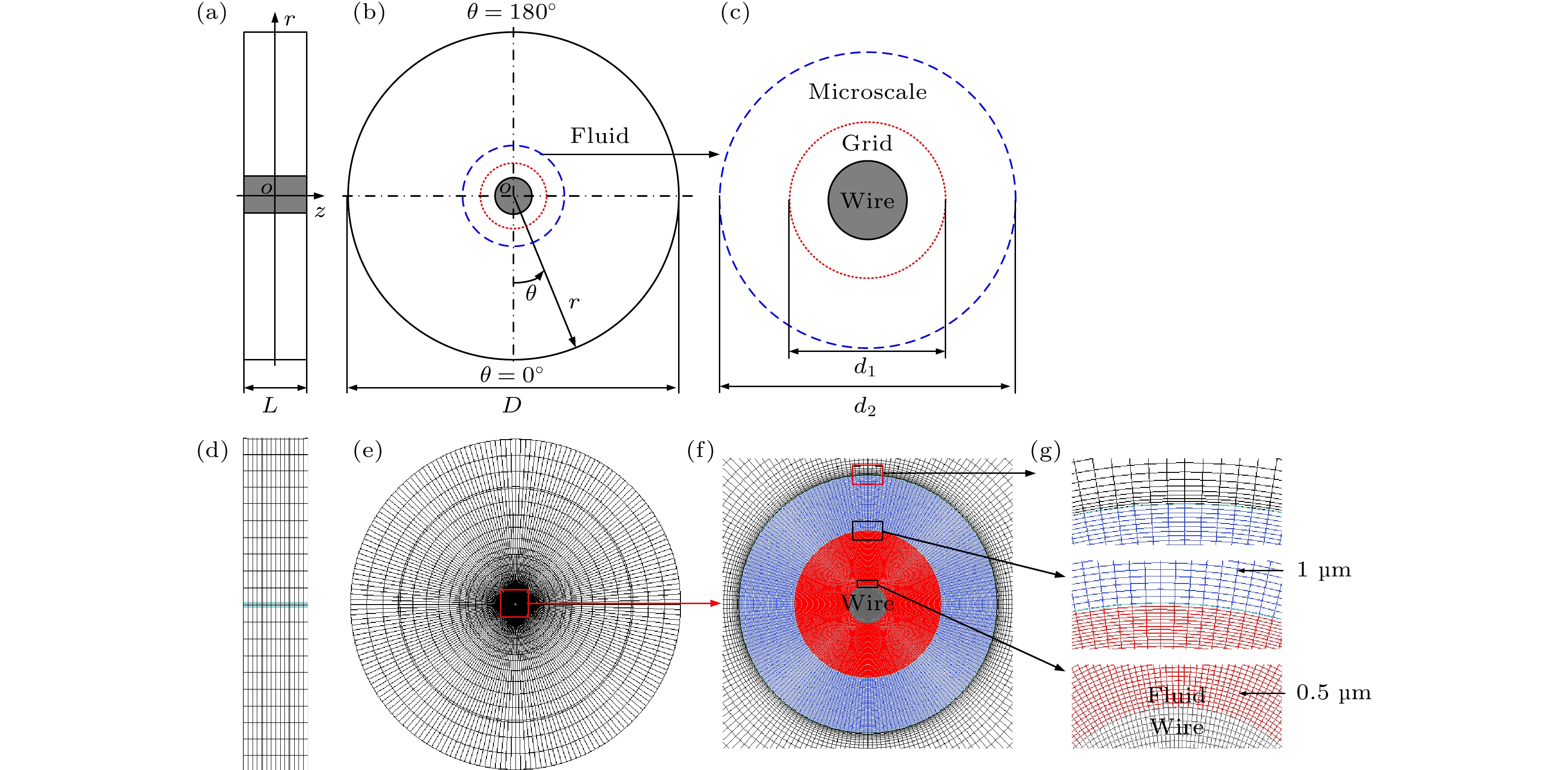
 下载:
下载:
